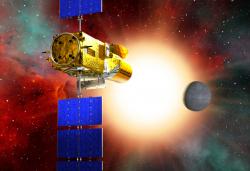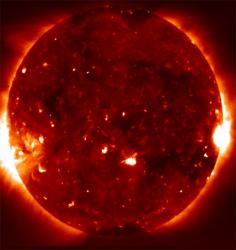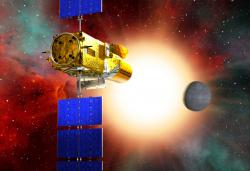 The debut launch of the Soyuz 2-1b rocket carried ESA’s COROT space telescope into orbit today. The rocket lifted off from the Baikonur Cosmodrome in Kazakstan at 1423 GMT (9:23 am EST). The Fregat upper stage successfully put the spacecraft into its final orbit about 50 minutes later.
The debut launch of the Soyuz 2-1b rocket carried ESA’s COROT space telescope into orbit today. The rocket lifted off from the Baikonur Cosmodrome in Kazakstan at 1423 GMT (9:23 am EST). The Fregat upper stage successfully put the spacecraft into its final orbit about 50 minutes later.
Continue reading “COROT is Blasted Into Space”
Early Images of the Sun From Hinode
 The recently launched Japanese Hinode spacecraft is turning in some amazing new photographs of the Sun as part of its checkout phase.
The recently launched Japanese Hinode spacecraft is turning in some amazing new photographs of the Sun as part of its checkout phase.
Next Up, the COROT Space Telescope
 Step aside Hubble, Chandra, Spitzer, there’s a new space telescope ready for launch. On December 27, 2006, the European Space Agency is planning to launch its planet hunting, starquake finding COROT satellite.
Step aside Hubble, Chandra, Spitzer, there’s a new space telescope ready for launch. On December 27, 2006, the European Space Agency is planning to launch its planet hunting, starquake finding COROT satellite.
Continue reading “Next Up, the COROT Space Telescope”
Rosetta Prepares for its Martian Close Up
Get ready Mars, you’re about to have a visitor. ESA’s Rosetta spacecraft, officially headed towards its 2014 encounter with comet 67P Churyumov-Gerasimenko, will pass by Mars in February 2007. This close encounter will give scientists an opportunity to test out Rosetta’s optics and scientific instruments on a well photographed target. Rosetta will also get a gravity assisted speed boost as it swings by the planet. Its closest approach will occur on February 25, when its passes just 250 km above the Martian surface.
Continue reading “Rosetta Prepares for its Martian Close Up”
Back to Venus with Vesper
While Venus is the same size as our Earth, its hellish surface environment makes it inhospitable to life. What went wrong with Venus? Now NASA is working on a new spacecraft called Vesper that could visit Venus, and try to get to the bottom of the question. Once launched, Vesper could begin orbiting Venus in March 2015. It would have a suite of instruments that would analyze the planet’s atmosphere over the course of two years.
Continue reading “Back to Venus with Vesper”
A New Target for Deep Impact
NASA announced today that it will be extending Deep Impact’s mission, giving it a chance to visit another comet. The mission made big news when it slammed an impactor spacecraft into Comet Tempel 1 in July, 2005. NASA had hoped they could steer the spacecraft past another comet, to continue its scientific discoveries. Mission planners chose Comet Boethin as the spacecraft’s next target, which it should be able to reach in December, 2008.
Continue reading “A New Target for Deep Impact”
New Planet Hunter Prepares for Launch
A powerful new instrument for finding extrasolar planets is about to launch: COROT (Convection Rotation and planetary Transits). Developed by the European Space Agency, COROT will search for planets using the transit method; it will be able to detect the slight drop in brightness as a planet moves in front of its parent star. If the observatory performs as expected, it should be able to detect rocky worlds just a few times larger than the Earth. COROT is scheduled to launch in December, 2006.
Continue reading “New Planet Hunter Prepares for Launch”
Successful Liftoff for NASA’s STEREO Spacecraft
NASA’s solar-observing STEREO spacecraft were carried into space Wednesday evening, atop a Boeing Delta II rocket. STEREO, aka the Solar Terrestrial Relations Observatories, are two nearly identical observatories that will help construct 3-dimensional views of the Sun and its stormy environment. Over the next few months, the spacecraft will perform a series of maneuvers so that one travels ahead of the Earth in orbit, and another trails behind the planet. This will give a view of the Sun from two different vantage points.
Continue reading “Successful Liftoff for NASA’s STEREO Spacecraft”
NASA’s Wise Satellite Moves Ahead
NASA’s Wide-field Infrared Survey Explorer team got the good news this week when their space telescope was approved for construction. Once in orbit, the “Wise” spacecraft will survey the entire sky in the infrared spectrum. This full-sky survey should turn up many previously unseen brown dwarf stars – objects too dim to be seen in previous surveys. It should also find some of the largest, most luminous galaxies in the Universe – some could be more than 11.5 billion light-years away. The $300 million spacecraft is expected to launch in 2009.
Continue reading “NASA’s Wise Satellite Moves Ahead”
Solar B Prepares for Launch
Solar flares are the most powerful explosions in the Solar System, releasing enormous energy in the form of radiation, high energy particles and magnetic fields. A new spacecraft, Solar B, developed by the Japanese Space Agency (JAXA) is set to launch on September 22, 2006, and will be able to detect these flares as they’re forming. The spacecraft will measure the movement of magnetic fields across the surface of the Sun, to help scientists predict when they will build up to a flare.
Continue reading “Solar B Prepares for Launch”
